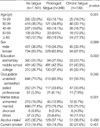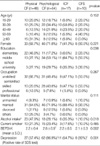1. Holmes GP, Kaplan JE, Gantz NM, Komaroff AL, Schonberger LB, Straus SE, Jones JF, Dubois RE, Cunningham-Rundles C, Pahwa S, Tosato G, Zegans LS, Putilo DT, Brown W, Schooley RT, Brus I. Chronic fatigue syndrome: a working case definition. Ann Intern Med. 1988. 108:387–389.

2. Fukuda K, Straus SE, Hickie I, Sharpe MC, Dobbins JG, Komaroff A. International chronic fatigue syndrome study group. The chronic fatigue syndrome: a comprehensive approach to its definition and study. Ann Intern Med. 1994. 121:953–959.
3. Lloyd AR, Hickie I, Boughton CR, Spencer O, Wakefield D. Prevalence of chronic fatigue syndrome in an Australian population. Med J Aust. 1990. 153:522–528.

4. Bates D, Schmitt W, Buchwald D, Ware NC, Lee J, Thoyer E, Kornish RJ, Komaroff AL. Prevalence of fatigue and chronic fatigue syndrome in a primary care practice. Arch Intern Med. 1993. 153:2759–2765.

5. Kroenke K, Wood DR, Mangelsdorff AD, Meier NJ, Powell JB. Chronic fatigue in primary care; prevalence, patient characteristics, and outcome. JAMA. 1988. 260:929–934.

6. Hickie IB, Hooker AW, Hadzi-Pavlovic D, Bennett BK, Wilson AJ, Lloyd AR. Fatigue in selected primary care settings: sociodemographic and psychiatric correlates. Med J Aust. 1996. 164:585–588.

7. Kim CH, Shin HC, Park YW. The prevalence of chronic fatigue and CFS-a hospital based study. J Korean Acad Fam Med. 2000. 21:1288–1298.
8. Shin HC, Kim CH, Park YW, Cho BL, Song SW, Yun YH, Ou SW. Validity of Zung's self-rating depression scale: Detection of depression in primary care. J Korean Acad Fam Med. 2000. 21:1317–1330.
9. Kim KN, Park JY, Shin TS, Jun KJ, Choi EY, Kim HJ, Lee SH, Yoo TW, Huh BY. Degree of stress and stress-related factors by the Korean version of the BEPSI. J Korean Acad Fam Med. 1998. 19:559–570.
10. Larkins RG, Molesworth SR. Chronic fatigue syndrome. Clinical practice guidelines. Med J Aust. 2002. 176:Suppl. S17–S55.

11. Buchwald D, Sullivan JL, Komaroff AL. Prevalence of 'chronic Ebstein-Barr virus infection' in a general medical practice. JAMA. 1987. 257:2303–2307.
12. Shahar E, Lederer J. Asthenic symptoms in a rural family practice: epidemiologic characteristics and a proposed classification. J Fam Pract. 1990. 31:257–262.
13. McDonald E, David AS, Pelosi AJ, Mann AH. Chronic fatigue in primary care attenders. Psychol Med. 1993. 23:987–998.

14. Verbrugge LM. Gender differences among patients with chronic fatigue. Clin Res. 1989. 26:156–182.
15. Steele L, Dobbins JG, Fukuda K, Reyes M, Randall B, Koppleman M, Reeves WC. The epidemiology of chronic fatigue in San Francisco. Am J Med. 1998. 105:83S–90S.

16. Minowa M, Jiamo M. Descriptive epidemiology of chronic fatigue syndrome based on a nationwide survey in Japan. J Epidemiol. 1996. 6:75–80.

17. Manu P, Lane TJ, Matthews DA. The frequency of the chronic fatigue syndrome in patients with symptoms of persistent fatigue. Ann Intern Med. 1988. 109:554–556.

18. Lawrie SM, Manders DN, Geddes JR, Pelosi AJ. A population based incidence study of chronic fatigue. Psychol Med. 1997. 27:343–353.
19. US Dept of Health and Human Statistics. Series 13, No 93. National Ambulatory Medical Care Survey, USA: 1975-1981 and 1985 Trends. 1988. Hyattsville, Maryland: National Center For Health Statistics.
20. Hammond E. Some Preliminary findings on physical complaints from a prospective study of 1,064,004 men and women. Am J Public Health Nations Health. 1964. 54:11–23.

21. Fuhrer R, Wessely S. The epidemiology of fatigue and depression in French primary care study. Psychol med. 1005. 25:895–905.
22. Lawrie SM, Pelosi AJ. Chronic fatigue syndrome in the community: prevalence and association. Br J Psychiatry. 1995. 166:793–797.
23. Buchwald D, Cheney PR, Peterson DL, Henry B, Wormsley SB, Geiger A, Ablashi DV, Salahuddin SZ, Saxinger C, Biddle R. A chronic illness characterized by fatigue, neurologic and immunologic disorders and active human herpes virus 6 type infection. Ann Intern Med. 1992. 116:103–113.
24. Barker E, Fujimura SF, Fadem MB, Landay AL, Levy JA. Immunologic abnormalities associated with chronic fatigue syndrome. Clin Infect Dis. 1994. 18:Suppl. S136–S141.

25. Lane TJ, Manu P, Matthews DA. Depression and somatization in the chronic fatigue syndrome. Am J Med. 1991. 91:335–344.

26. David AS, Wessely S, Pelosi AJ. Chronic fatigue syndrome: Signs of a new approach. Br J Hosp Med. 1991. 45:158–163.
27. Henningsen P, Zimmermann T, Sattel H. Medically unexplained physical symptoms, anxiety, and depression: a meta-analytic review. Psychosom Med. 2003. 65:528–533.









 PDF
PDF ePub
ePub Citation
Citation Print
Print



 XML Download
XML Download